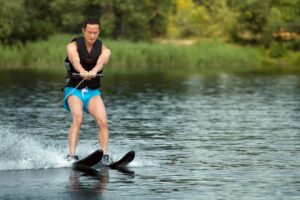Get in shape for wakeboarding and waterskiing season
In some parts of Canada, summer has been slow to emerge, but we know the warm weather is just around the corner. And in Ontario the hot muggy days have arrived. Now is the time to start planning for a fun, safe, and injury-free wakeboard and water ski season. Whether you’re a newbie or a seasoned wave rider, preventing injuries is crucial by implementing proper wakeboard training. Working on your strength and flexibility is key to getting in shape for wakeboarding. We all love seeing more backrolls and ollies, and fewer face plants! So, get ready to hit the water and make this season your best one yet!
Fundamentals for mastering wakeboarding
If you are new to wakeboard and waterskiing, the number one thing to focus on is mastering the proper stance and balance. By concentrating on these fundamentals, you’ll establish a solid foundation for more advanced techniques and tricks as you progress in wakeboarding. Take a few minutes to watch some training videos, and as with any sport, go with someone who is experienced they can help guide you and give you tips and tricks for getting up and staying up. Getting in shape for waterskiing doesn’t have to be complicated. Some of the best training exercises can be done at home without expensive gym equipment.
The most common wakeboard injury
Along with snowboarding and skiing, the most common injury in wakeboarding is an anterior cruciate ligament (ACL) tear or injury. This is common without wakeboard training. The ACL is a critical ligament in the knee, and it is particularly vulnerable during the high-impact landings and sudden directional changes that are typical in wakeboarding. These injuries often occur when the knee is twisted or hyperextended during jumps and landings. Proper training, using the correct techniques, and wearing appropriate protective gear can help mitigate the risk of ACL injuries.

Understanding physiology and corresponding exercises for wakeboard training
Understanding the physiology of the body related to exercises for wakeboarding involves understanding how specific exercises enhance the functions of muscles and systems that are crucial for the sport. Here’s a breakdown:
Core muscles
- Physiology: The core muscles provide stability and balance including the obliques, lower back muscles, and abdominals.
- Exercises: Planks, Russian twists, leg raises and bicycle crunches
- Function: Strong core muscles help maintain an upright posture, balance on the board, and perform rotational movements essential for tricks.
Leg muscles
- Physiology: The quadriceps, hamstrings, glutes, and calves generate power and stability.
Exercises: Squats, lunges, deadlifts, and calf raises. - Function: These muscles are critical for jumping, maintaining a stable stance, absorbing impacts, and controlling the board.
Upper body muscles
- Physiology: The muscles in the shoulders, back, and arms, including the deltoids, trapezius, and biceps, are important for handling the tow rope and performing tricks.
- Exercises: Pull-ups, push-ups, dumbbell rows, and shoulder presses.
- Function: Strong upper body muscles help with grip strength, pulling oneself up, and maintaining control during movements and jumps.
Cardiovascular system
- Physiology: The heart and lungs work together to supply oxygen to the muscles during exercise.
Exercises: Cardiovascular exercises like running, cycling, and swimming. - Function: Improved cardiovascular endurance ensures sustained energy and performance on the water.
Flexibility
- Physiology: Flexible muscles and joints enhance the range of motion and reduce the risk of injury.
Exercises: Dynamic stretching, yoga, Pilates and flexibility routines. - Function: Flexibility helps in performing various movements smoothly and reduces the likelihood of strains and sprains.
Nervous system
- Physiology: The nervous system coordinates muscle movements.
- Exercises: Balance exercises, coordination drills, and agility training.
- Function: Improved coordination and balance are vital for reacting quickly and maintaining control on the board.
Injury prevention
- Physiology: Strengthen supporting muscles and stabilizing joints reduces the risk of common wakeboarding injuries, such as ACL tears and shoulder dislocations.
- Exercises: Targeted strength training, proprioceptive exercises, and proper warm-up and cool-down routines.
- Function: Preventive exercises help maintain joint integrity and muscle balance, ensuring safer wakeboarding sessions.
Don’t go in the water before a warmup: Here is a great 5 min warm up video with MadFit
Two other important things to focus on when training are sleep and nutrition. Both play a key role in our health and injury prevention. And with any sport, don’t forget to warm up before you get out on the lake to ski. The best thing about wakeboarding is that Canada has so many lakes to get your shred on!
Train with a pro
If needed, seek assistance from a professional. Hire a knowledgeable personal trainer or physical therapist to help you manage old injuries and create a strength and flexibility program. Additionally, always consult a physician before starting any exercise regimen.
Resources for wakeboard training
Wakeboarding Mag: How to get in shape for the season.
In your home therapy: Wakeboarding workouts for peak performance
Discover Boating: Top 10 wakeboard workouts
Discover Boating: Five ways to help your kids wakeboard